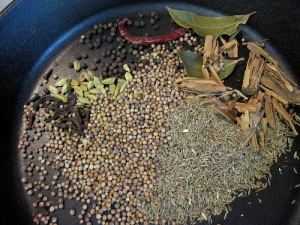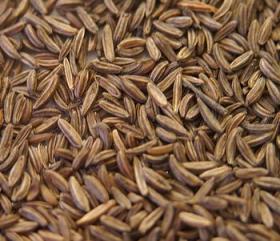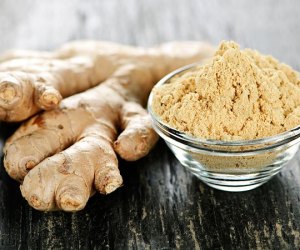The kingdom of Pepper was sometimes affectionately called by its old, Norse name: Pepper & Pink. It wasn’t a vast land, but every square inch seemed to be populated by various forms of pepper. From the biting burst of freshly ground Malabar nuggets to the cedar trees which swathed its flanks from North to South and the great lakes of ISO E Super which dotted the landscape. It was ruled by a king called Ginger who was a chef at heart, willy-nilly tossing in spices off the royal balcony to his people below. For the most part, his subjects were a homogeneous people, descended either from the tribe of Pepper or from the royal house of Ginger. A small minority hailed from the nomads called Pink Rose. They were a demure lot, always dainty and shy, reeking of the pinkest, lightest, most translucent rose that was to be found. They were so quiet at times that haughty critics like Luca Turin sneering called them “Not Rose,” while others though they were mere myths and didn’t even believe they existed. Certainly, they were far outnumbered by the Peppers, with their fiery bite, and by the more rambunctious royal Gingers, but all of them were all ruled by the vast plains of cedar trees and the large lakes of ISO E Super.
That is the kingdom of Rose 31, a creation from the niche perfume house, Le Labo. A much-loved fragrance, Rose 31 is an eau de parfum whose number — 31 — purportedly refers to the number of its ingredients. Now Smell This explains more:
[Le Labo was] established by Fabrice Penot and Eddie Roschi (both formerly of Giorgio Armani fragrances) in 2006. Le Labo started with 10 fragrances by well-known perfumers, and is known for blending the essential oils with alcohol and water at the time of purchase and providing customized labels for the bottles.
Initial releases in early 2006 were Fleur d’Oranger 27, Jasmin 17, Labdanum 18 (originally Ciste 18), Ambrette 9, Iris 39, Bergamote 22, Rose 31, Vetiver 46, Patchouli 24 and Neroli 36. In each case, the number in the fragrance name refers to the number of notes that make up the scent’s composition, and the name is taken from the ingredient in the highest concentration; to take one example, Jasmin 17 has 17 ingredients, with jasmine being in the highest concentration. The names are thus not necessarily related to what the fragrance is meant to smell like.
 The issue of not smelling like what it is named is something that actually comes up quite a bit with regard to Rose 31. Fragrantica classifies Rose 31 as a “floral woody musk” and says it was created by Daphne Bugey. Some of its 31 notes — as compiled from both Fragrantica, Luckyscent, and my own nose — are as follows:
The issue of not smelling like what it is named is something that actually comes up quite a bit with regard to Rose 31. Fragrantica classifies Rose 31 as a “floral woody musk” and says it was created by Daphne Bugey. Some of its 31 notes — as compiled from both Fragrantica, Luckyscent, and my own nose — are as follows:
Grasse rose, caraway, cumin, pepper, clove, nutmeg, cedar, ISO E Super, frankincense, amber, labdanum, vetiver, guaiac wood, animalic notes, and agarwood (oud).
I tested Rose 31 twice, to slightly different outcomes in terms of the opening burst. The first time, the perfume opened with almost entirely peppered, woody and spiced notes, followed on only much later by a minute trace of rose. The second time, the rose was upfront, and present from the start. I’ll cover both beginnings.
During that first test, Le Labo’s opening consisted of galloping amounts of pepper, sharp and backed by peppery cedary woods, and what felt like a light dash of ISO E Super. For those unfamiliar with the aroma-chemical, you can read my full description of its pros and cons here, especially as I’ll be mentioning ISO E Super quite a bit in this review. In a nutshell, though, the synthetic is used most frequently for two reasons: 1) as a super-floralizer which is added to expand and magnify many floral notes, along with their longevity; and 2) to amplify woody notes and add a velvety touch to the base. It seems to be particularly used in fragrances that have vetiver or, to a lesser extent, other wood notes like cedar. ISO E Super always smells extremely peppery and, in large doses, has an undertone that is like that of rubbing alcohol, is medicinal, and/or astringent. To those unfamiliar with the synthetic, all they detect is “extra, extra pepperiness.” Some people are completely anosmic to the note, while others get extreme headaches from it. (Ormonde Jayne fragrances, and others like Lalique‘s Encre Noire or Terre d’Hermès are particularly egregious in that respect.) I don’t get headaches from ISO E Super, but I cannot stand it in large quantities and I can detect its peppered element with its rubbing alcohol base a mile away.
Thankfully for me, the ISO E Super is light at the start, outweighed fully by a glorious complement of spices that feel as though a mad chef went to town like a dervish. I really adore that first opening to Rose 31 that I experienced. There is the most miniscule dash of cumin — powdery, dusty, a wee bit animalic, and nothing like that used in Indian curries. Much more prominent, however, are the caraway seeds which feel nutty, a little anise-like in tone, and a bit woody. (Technically, there is a difference between caraway and cumin. The terms may be used interchangeably by many, but that would be a mistake as they are not the same thing and their aroma, to my nose at least, differs in undertone.)

Source: Girl’s Gone Child at Girlsgonechild.net. (Link embedded within. Click on photo.)
http://www.girlsgonechild.net/2011/12/eat-well-gift-of-garam-masala.html
Both spices share equal space on Le Labo’s stage with heaping cups of ginger that is, simultaneously, both freshly pungent and spicy, and slightly crystallized and sweet. There are whiffs of nutmeg that subtly add a sharp, bitter edge to the perfume, along with the spicy, red-hot kick of cloves. The whole thing is covered by a heavy veil of pepper that feels as though a chef just emptied an entire bottle of Malabar peppercorns with the rest of the spices into a sauté pan to roast, bringing out their bite, their fire, and their subtle earthy woodiness. In the background, there are flickers of white smoke from frankincense.
The dominance of the cedar, underscored by the ISO E Super, and the pepper ensures a perfect balance between woods and spices. Rose 31 never feels like a dusty, spice shop, but nor does it feel like a purely woody fragrance either. Well, at this stage, anyway. The powerful ginger that threads its way throughout much of Rose 31’s tapestry also ensures a subtle freshness and zing to the scent. When you add in the beautiful frankincense smoke — never cold, musty, earthy or dank, but sweet and almost earthy — the result in those opening minutes is utterly fascinating.
During that first test, I found myself agreeing a little with Luca Turin, the famous perfume critic, whose low, two-star review of Le Labo Rose 31 in Perfumes: The A-Z Guide is sneeringly entitled “Not Rose.” I hate agreeing with Luca Turin on anything; it almost offends my soul. Though I didn’t share his contemptuous views of the perfume as whole, I had to reluctantly admit that I couldn’t detect a trace of rose anywhere in that first hour. I even looked up some reviews for Rose 31 in which people wrote with utter bafflement about how completely nonexistent the rose was on their skin, no matter how many times they tested the perfume.
Then, I did the second test, and all the notes I wrote about earlier were backed from the start by the presence of the flower. It’s not huge, but the rose is definitely there, almost translucent in its pinkness and dainty freshness. Oddly, it never felt imbued by the heaping dollops of pepper; instead, to my nose, it almost stood apart, never tainted by the fiery, spicy notes, but remaining something dainty, sweet, and light. It was very pretty and well-meshed into the fragrance, but, unexpectedly, I found the non-rose opening in the first test to be much more interesting, and unusual. (The word “fascinating” appears more than a handful of times in my notes.)
Regardless of that small difference, the perfume’s development subsequently remained the same during both tests. Fifteen minutes in, the oud appears. It is not medicinal, astringent, or evocative of pink rubber bandages (my most hated form of oud). Instead, it is a bit more fiery and yet another source of pepper added to the mix. It also has a subtle, delicate undercurrent of honey which makes it quite lovely. As some of my regular readers know, I’ve got oud-fatigue, but this is an absolutely brilliant and fitting way to use the note, taking advantage of one of its intrinsic qualities to shore up the general peppered cocktail of notes. What helps with my enormous enthusiasm is the growing honeyed sweetness of Rose 31, the perfectly blended balance of notes, and the way in which each one mixes into a harmonious, greater whole. Truth be told, I was rather shocked by how much I initially liked this perfume, since I certainly didn’t expect it. Then again, I thought I’d be smelling yet another rose-wood-oud fragrance.
The oud is merely a muted backdrop player at this point, along side that other shadowing ghost, the ISO E Super, and all of them subsumed under the powerful ginger note. As time passes, the latter feels incredibly dominant, bringing back some memories of Versace‘s Crystal Noir in which pepper and ginger also perform a key duet. (Its top notes are pepper and ginger, with cardamom in lieu of the clove and nutmeg here.) Then, finally, at the end of the first hour, the rose makes its hesitant appearance. It’s slight, far from heavy in texture, and never feels jammy or fruited; instead, it’s almost watery and tea-rose like in nature.
Unfortunately for me and my joy at that wonderful opening, the 90 minute mark ushers in a strong wave of ISO E Super. Words cannot begin to describe my disappointment as that annoying subtext of rubbing alcohol begins its steady thrumming beat in the background. There is still heavy amounts of ginger, pepper and frankincense, but the growing force of the cedar woods and ISO E dominate. Even the oud and guaiac seem to have grown a little in strength — just two more sources of peppered woods that soon overtake the entire perfume. By the end of my second test, I felt almost browbeaten into submission but that constant, one-note, drumming beat.
The great nuances of the opening start, the complexity of the notes, the fascinating juxtapositions, and that perfect balancing act are all gone — thrown asunder by the top-heavy, unbalanced cedar-pepper-ginger-ISO E Super combination. Sure, there are flickers of other things that occasionally pop up: vetiver makes a late appearance with a darkly rooty, earthy accord; bitter nutmeg and honeyed labdanum dance around the far edges once in a blue moon; and subtle muskiness is a quiet vein underneath. But, they are tiny in nature and degree. Instead, for hours and hours and hours, it’s primarily just various sources of dark, peppered woods. The drydown doesn’t make me happier, either, because, five hours in, Rose 31 turns into an abstract, amorphous, generalized woody scent, with a hint of gingery rose and the start of soapiness. Eventually, that soapiness starts to take over until, in its final hours, Rose 31 is nothing more than a vague, musky, woody, soap scent. What a huge disappointment after that first glorious hour!
All in all, Rose 31 lasted just a wee bit over 9.5 hours on my perfume consuming skin. The sillage was initially excellent, though it quickly dropped after the first hour to become just a few inches above the skin. The perfume became a skin scent around the 5th hour, the same time when the drydown began and Rose 31 lost its shape entirely. On Fragrantica, the overwhelming majority of votes puts the sillage at “moderate” and the longevity at “long-lasting,” though there are a handful of votes for “poor” and “moderate” as well.
As noted earlier, Luca Turin is not a fan of Rose 31. In Perfumes: The A-Z Guide, his short, succinct assessment is incredibly harsh:
This aldehydic carrot juice was, unaccountably, composed by the brilliant Daphné Bugey, of Firmenich, who did Kenzo Amour and four sensational (and as yet unavailable) Coty reconstructions. Is Le Labo some sort of rehab where perfumers go when their noses are tired?
Ouch! Well, I rarely agree with Luca Turin, and I certainly won’t start now. I think the perfume is better than he believes, though I’m not sure that’s saying much. Clearly, Rose 31 is far from my personal cup of tea. As a side note about Daphné Bugey creating Kenzo Amour: that fragrance is listed as one of the perfumes with the most amount of ISO E Super, a whopping 48% according to the Perfume Shrine. As a result, it is often mentioned by people as a fragrance that gives them a searing headache. But ignoring the headache-inducing qualities of the ISO E Super, Rose 31’s eventual tidal wave of the synthetic — and the parallel way in which the pepper note is created by every possible source — suddenly makes a lot more sense. Perfumers who love ISO E Super just can’t seem to let go of it. (Geza Schoen, I’m staring straight at you!)
General reviews of Le Labo Rose 31 seem evenly split between those who find the cedar note to be unbalanced and overwhelming, and those who love the fragrance. A number of those in the latter category repeatedly comment on how the opening of Rose 31 reminds them of Caron‘s much beloved Poivre Sacré. I haven’t tried the latter, so I can’t help. But perhaps a sampling of Fragrantica opinions on the perfume will provide some light on whether you’d like the perfume or not:
- Although I absolutely do not enjoy this fragrance, I need to give credit where credit is due. Immediately, the rose is detectable upon the initial spray/splash of the top notes and for me, that’s all I detect. It’s a very subdued yet masculine rose that exudes something very sensual but as the basenotes appear, that all changes. One thing, out of all the rose scents that I’ve encountered, this one has to be the most natural but when the cedar arrives, it ruins the whole aura of the scent. The cedar is too overpowering/cloying and masks everything the rose is trying to present. The two blended extremes almost seem to be competing with one another only the cedar always has the upper-hand. […]
- The top notes are very peppery in the same vibe of Caron’s Parfum Sacre, but then the cumin and cedar take top places, I find quite nice but I think suits a man better because of the cedar and have a very wood basenote.
- Perfumes containing rose and spice are always dark, heavy, and complex. Rose 31 seems unnaturally crisp and ethereal. I think it contains a lot of Iso E Super, which usually smells so synthetic, but it seems to work so well here. [¶] The rose is a clean, magenta rose that reminds me of the Enchanted Rose in Beauty and the Beast that is protected under a crystal dome–perfect and sparkling in a way that only a fairy tale could be. [¶] I don’t smell cumin. Instead I smell a something like a translucent cinnamon hard candy. […]
- there is hardly any rose in it, it is a very nice woody fragrance though
- Dark prickly aldehydes and musk and woods. Like most Le Labos they seem to have forgotten to put the main ingredient in. […]
- There’s no rose in this perfume. NO Rose. Period. [¶] What IS there? Well, there’s musk, woods, some kind of flower and some kind of vegetable, and more musk. Clean musk. Nothing spicy, nothing dirty. If one uses his imagination, it could be described as “dark”, I guess; but I wouldn’t.
- smells like soap in bad way
Confused? Well, as I mentioned at the start, the main issue seems to be whether the rose note appears or not. And the bottom line seems to be that — even for those who do smell it — the cedar and woodsy notes eventually take over and, then, fully dominate. Whether you smell the ISO E Super (and yay for one Fragrantica poster who smelled loads of it!), the musk, the soap, or the other spices, the main thing you’re bound to take away from the fragrance is dark, peppered, cedary woods. You may have noticed that the photos of the woods in this review have gone from: rosy, warm, and multi-faceted; to gold-tinged and autumnal; to dark sepia; finally ending with dark black with soapy white. That’s very intentional. It’s really how this perfume feels to me in large part.
If you love cedar, then you should definitely try Rose 31. All the other notes may just be an added bonus. If you’re not a fan of highly peppered woods — especially in perfumes that bang that main drumbeat for hours on end — then you won’t enjoy Rose 31. It’s really as simple as that.






